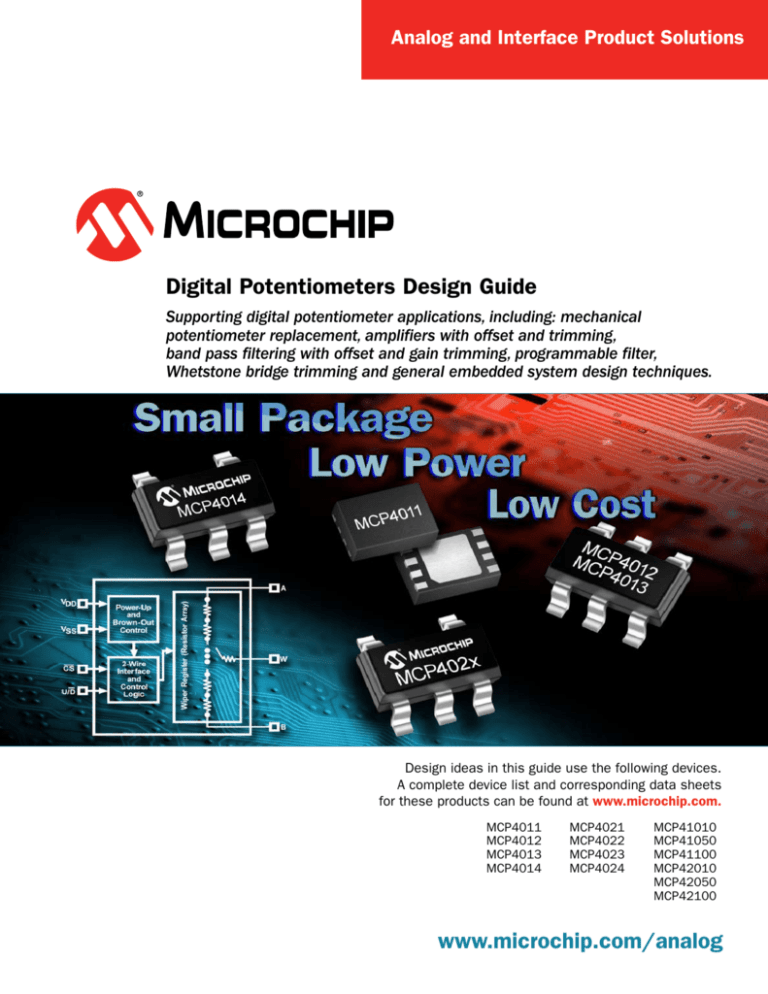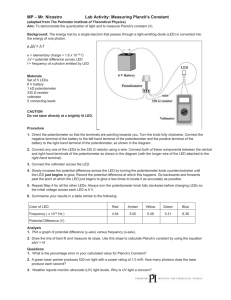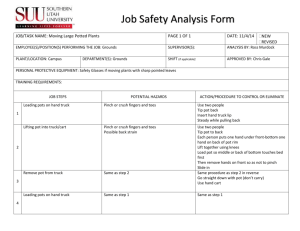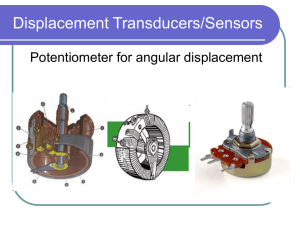
Analog and Interface Product Solutions
Digital Potentiometers Design Guide
Supporting digital potentiometer applications, including: mechanical
potentiometer replacement, amplifiers with offset and trimming,
band pass filtering with offset and gain trimming, programmable filter,
Whetstone bridge trimming and general embedded system design techniques.
Design ideas in this guide use the following devices.
A complete device list and corresponding data sheets
for these products can be found at www.microchip.com.
MCP4011
MCP4012
MCP4013
MCP4014
MCP4021
MCP4022
MCP4023
MCP4024
MCP41010
MCP41050
MCP41100
MCP42010
MCP42050
MCP42100
www.microchip.com/analog
Digital Potentiometer Solutions
Microchip’s Family of Digital Potentiometers
Microchip offers a range of devices that allow the
customer to select a device that is a best fit for their
application. Some of the selection options include:
A wide range of resistor values
– RAB resistance (typical) from 2.1 kΩ to 100 kΩ
Step resolution
– 6-bit
– 8-bit
Serial Interfaces
– Up/Down
– SPI
Memory Types
– Volatile
– Non-volatile
Resistor Network Configurations
– Potentiometer (Resistor divider)
– Rheostat (Variable resistor)
Single/dual Potentiometer Options
Package Options
Special Features
– Shutdown Mode
– WiperLock™ Technology
Low Voltage, Low Power Options
Resistor sizes and resolutions allow the designer to
select the step resistance and number of steps. For the
device with the resistance (RAB) equal to 2.1 kΩ, there
are 64 steps (63 resistors), so the step resistance (RS)
equals RAB/63 (or 33.33Ω). Now at the other end of the
spectrum, for the device with the resistance (RAB) equal
to 50 kΩ, there are 64 steps (63 resistors), so the step
resistance (RS) equals RAB/63 (or 793.65Ω).
2
Digital Potentiometer Design Guide
The serial interface options allow the designer to easily
integrate the device into the application. For some
applications the simple Up/Down interface will be
adequate, while for other applications the SPI interface will
better meet their system requirements.
The availability of both volatile and non-volatile devices
allows the designer flexibility in optimizing the application.
Some applications may use the digital potentiometer as a
replacement for a mechanical potentiometer. In this case,
a non-volatile device with the serial interface connecting to
the test hardware interface allows a low cost device with
low cost manufacturing.
Resistor Network configurations allow the package size/
cost to be minimized for the desired functionality. If a
variable resistor (rheostat) with one terminal tied
to ground is desired, then only one resistor terminal
(the wiper) needs to be implemented. In the MCP402X
family, this configuration is shown in the MCP4024 and
allows the functionality to be achieved in the low-cost
SOT-23-5 package. The potentiometer pinout with all
terminals available requires an 8-pin package.
Dual potentiometer options allow the customer to have
potentiometers/variable resistors that are closely matched
in the system, since the two devices are on the same
device die.
Packaging options allow customers to address their
system requirement trade-offs including device cost,
board area, and manufacturing sites (surface mount vs.
thru-hole). Packages include tiny 3x3 SOT-23 and 3x2 DFN
packages.
Digital Potentiometer Solutions
Low Power Applications
Low Voltage Applications
Many applications are very power sensitive. Typically, these
are battery powered applications. Microchip Technology’s
MCP401X, MCP402X, MCP41XXX and MCP42XXX have a
maximum IDD of 1 μA when the serial interface is inactive.
The non-volatile memory is also not being programmed for
the MCP402X device.
Low power devices include: MCP4011, MCP4012,
MCP4013, MCP4014, MCP4021, MCP4022, MCP4023
and MCP4024.
Some applications require a low operating voltage.
Microchip offers devices that operate down to 1.8V, which
are useful for many battery applications. At these lower
voltages (below 2.7V), the analog performance of the
device is not specified, but is characterized. For many
applications this may be acceptable.
1.8V operational devices include: MCP4011, MCP4012,
MCP4013 and MCP4014.
Note 1:
2:
3:
4:
Shutdown
Mode
Configuration
Voltage
Range
# of Pins
8
8
8
8
6
6
6
6
6
6
6
6
5
5
5
5
8
8
8
8
6
6
6
6
6
6
6
6
5
5
DFN, MSOP, SOIC
DFN, MSOP, SOIC
DFN, MSOP, SOIC
DFN, MSOP, SOIC
SOT-23
SOT-23
SOT-23
SOT-23
SOT-23
SOT-23
SOT-23
SOT-23
SOT-23
SOT-23
SOT-23
SOT-23
DFN, MSOP, SOIC
DFN, MSOP, SOIC
DFN, MSOP, SOIC
DFN, MSOP, SOIC
SOT-23
SOT-23
SOT-23
SOT-23
SOT-23
SOT-23
SOT-23
SOT-23
SOT-23
SOT-23
1
1
1
1
1
1
1
1
1
1
1
1
1
1
1
1
1
1
1
1
1
1
1
1
1
1
1
1
1
1
63
158.73
Y/Y
1
Y
N
Rheo
2.7V to 5.5V
5
SOT-23
1
63
793.65
Y/Y
1
Y
N
Rheo
2.7V to 5.5V
5
SOT-23
1
V
V
V
V
V
V
V
V
V
V
V
V
V
V
V
V
NV
NV
NV
NV
NV
NV
NV
NV
NV
NV
NV
NV
NV
NV
6-bit
6-bit
6-bit
6-bit
6-bit
6-bit
6-bit
6-bit
6-bit
6-bit
6-bit
6-bit
6-bit
6-bit
6-bit
6-bit
6-bit
6-bit
6-bit
6-bit
6-bit
6-bit
6-bit
6-bit
6-bit
6-bit
6-bit
6-bit
6-bit
6-bit
63
63
63
63
63
63
63
63
63
63
63
63
63
63
63
63
63
63
63
63
63
63
63
63
63
63
63
63
63
63
-103
10.0
Up/Down
NV
6-bit
-503
50.0
Up/Down
NV
6-bit
IDD max
(μA)(3)
WiperLock™
Technology
1.8V to 5.5V(4)
1.8V to 5.5V(4)
1.8V to 5.5V(4)
1.8V to 5.5V(4)
1.8V to 5.5V(4)
1.8V to 5.5V(4)
1.8V to 5.5V(4)
1.8V to 5.5V(4)
1.8V to 5.5V(4)
1.8V to 5.5V(4)
1.8V to 5.5V(4)
1.8V to 5.5V(4)
1.8V to 5.5V(4)
1.8V to 5.5V(4)
1.8V to 5.5V(4)
1.8V to 5.5V(4)
2.7V to 5.5V
2.7V to 5.5V
2.7V to 5.5V
2.7V to 5.5V
2.7V to 5.5V
2.7V to 5.5V
2.7V to 5.5V
2.7V to 5.5V
2.7V to 5.5V
2.7V to 5.5V
2.7V to 5.5V
2.7V to 5.5V
2.7V to 5.5V
2.7V to 5.5V
Up/Down
Up/Down
Up/Down
Up/Down
Up/Down
Up/Down
Up/Down
Up/Down
Up/Down
Up/Down
Up/Down
Up/Down
Up/Down
Up/Down
Up/Down
Up/Down
Up/Down
Up/Down
Up/Down
Up/Down
Up/Down
Up/Down
Up/Down
Up/Down
Up/Down
Up/Down
Up/Down
Up/Down
Up/Down
Up/Down
Packages
# of Channels
MCP4024
Zero-Scale/
Full-Scale(1)
MCP4023
Pot
Pot
Pot
Pot
Rheo
Rheo
Rheo
Rheo
Pot
Pot
Pot
Pot
Rheo
Rheo
Rheo
Rheo
Pot
Pot
Pot
Pot
Rheo
Rheo
Rheo
Rheo
Pot
Pot
Pot
Pot
Rheo
Rheo
# RS
Resistors
MCP4022
N
N
N
N
N
N
N
N
N
N
N
N
N
N
N
N
N
N
N
N
N
N
N
N
N
N
N
N
N
N
Resolution
MCP4021
N
N
N
N
N
N
N
N
N
N
N
N
N
N
N
N
Y
Y
Y
Y
Y
Y
Y
Y
Y
Y
Y
Y
Y
Y
Volatile
Non-Volatile
MCP4014
1
1
1
1
1
1
1
1
1
1
1
1
1
1
1
1
1
1
1
1
1
1
1
1
1
1
1
1
1
1
Serial
Interface
MCP4013
Y/Y
Y/Y
Y/Y
Y/Y
Y/Y
Y/Y
Y/Y
Y/Y
Y/Y
Y/Y
Y/Y
Y/Y
Y/Y
Y/Y
Y/Y
Y/Y
Y/Y
Y/Y
Y/Y
Y/Y
Y/Y
Y/Y
Y/Y
Y/Y
Y/Y
Y/Y
Y/Y
Y/Y
Y/Y
Y/Y
2.1
5.0
10.0
50.0
2.1
5.0
10.0
50.0
2.1
5.0
10.0
50.0
2.1
5.0
10.0
50.0
2.1
5.0
10.0
50.0
2.1
5.0
10.0
50.0
2.1
5.0
10.0
50.0
2.1
5.0
RAB (kΩ)
(typ.)
MCP4012
33.33
79.37
158.73
793.65
33.33
79.37
158.73
793.65
33.33
79.37
158.73
793.65
33.33
79.37
158.73
793.65
33.33
79.37
158.73
793.65
33.33
79.37
158.73
793.65
33.33
79.37
158.73
793.65
33.33
79.37
-202
-502
-103
-503
-202
-502
-103
-503
-202
-502
-103
-503
-202
-502
-103
-503
-202
-502
-103
-503
-202
-502
-103
-503
-202
-502
-103
-503
-202
-502
Device
MCP4011
RS (Ω)
(typ.)
Product Specifications
Zero-scale allows the wiper to “directly” connect to Terminal B, while full-scale allows the wiper to “directly” connect to Terminal A.
There is one RS resistor between the maximum wiper value and Terminal A.
This current is with the serial interface inactive, and not during an EEPROM write cycle (for non-volatile devices).
The serial interface has been tested to 1.8V, the device’s analog characteristics (resistor) have been tested from 2.7V to 5.5V. Review the device’s characterization graphs for
information on analog performance between 1.8V and 2.7V.
Digital Potentiometer Design Guide
3
Digital Potentiometer Solutions
Small Footprint Applications
Small Footprint Devices
Some applications require devices with tiny footprints.
Microchip offers several devices in very small form factor
packages.
Small footprint devices include: MCP4011, MCP4012,
MCP4013, MCP4014, MCP4021, MCP4022, MCP4023
and MCP4024.
MSOP
SOT-23
3 mm
5 mm
ALLER
60% SM OP and
S
than M ALLER
33% SM OT-23
than S
ALLER
40% SM SOP
than M
DFN
3 mm
2 mm
3 mm
3 mm
Package
MSOP
SOT-23
DFN
Area
(mm2)
15
9
6
# of Channels
WiperLock™
Technology
Shutdown
Mode
Configuration
Voltage
Range
6-bit
63
33.33
Y/Y
1
N
N
Pot
1.8V to 5.5V(4)
V
V
V
V
6-bit
6-bit
6-bit
6-bit
63
63
63
63
79.37
158.73
793.65
33.33
Y/Y
Y/Y
Y/Y
Y/Y
1
1
1
1
N
N
N
N
N
N
N
N
Pot
Pot
Pot
Rheo
1.8V to 5.5V(4)
1.8V to 5.5V(4)
1.8V to 5.5V(4)
1.8V to 5.5V(4)
MCP4011
MCP4012
-502
-103
-503
-202
5.0
10.0
50.0
2.1
Up/Down
Up/Down
Up/Down
Up/Down
V
V
V
V
6-bit
6-bit
6-bit
6-bit
63
63
63
63
79.37
158.73
793.65
33.33
Y/Y
Y/Y
Y/Y
Y/Y
1
1
1
1
N
N
N
N
N
N
N
N
Rheo
Rheo
Rheo
Pot
1.8V to 5.5V(4)
1.8V to 5.5V(4)
1.8V to 5.5V(4)
1.8V to 5.5V(4)
MCP4013
-502
-103
-503
-202
5.0
10.0
50.0
2.1
Up/Down
Up/Down
Up/Down
Up/Down
V
V
V
V
6-bit
6-bit
6-bit
6-bit
63
63
63
63
79.37
158.73
793.65
33.33
Y/Y
Y/Y
Y/Y
Y/Y
1
1
1
1
N
N
N
N
N
N
N
N
Pot
Pot
Pot
Rheo
1.8V to 5.5V(4)
1.8V to 5.5V(4)
1.8V to 5.5V(4)
1.8V to 5.5V(4)
MCP4014
-502
-103
-503
-202
-502
-103
-503
-202
-502
-103
-503
-202
-502
-103
-503
-202
-502
5.0
10.0
50.0
2.1
5.0
10.0
50.0
2.1
5.0
10.0
50.0
2.1
5.0
10.0
50.0
2.1
5.0
Up/Down
Up/Down
Up/Down
Up/Down
Up/Down
Up/Down
Up/Down
Up/Down
Up/Down
Up/Down
Up/Down
Up/Down
Up/Down
Up/Down
Up/Down
Up/Down
Up/Down
V
V
V
NV
NV
NV
NV
NV
NV
NV
NV
NV
NV
NV
NV
NV
NV
6-bit
6-bit
6-bit
6-bit
6-bit
6-bit
6-bit
6-bit
6-bit
6-bit
6-bit
6-bit
6-bit
6-bit
6-bit
6-bit
6-bit
63
63
63
63
63
63
63
63
63
63
63
63
63
63
63
63
63
79.37
158.73
793.65
33.33
79.37
158.73
793.65
33.33
79.37
158.73
793.65
33.33
79.37
158.73
793.65
33.33
79.37
Y/Y
Y/Y
Y/Y
Y/Y
Y/Y
Y/Y
Y/Y
Y/Y
Y/Y
Y/Y
Y/Y
Y/Y
Y/Y
Y/Y
Y/Y
Y/Y
Y/Y
1
1
1
1
1
1
1
1
1
1
1
1
1
1
1
1
1
N
N
N
Y
Y
Y
Y
Y
Y
Y
Y
Y
Y
Y
Y
Y
Y
N
N
N
N
N
N
N
N
N
N
N
N
N
N
N
N
N
Rheo
Rheo
Rheo
Pot
Pot
Pot
Pot
Rheo
Rheo
Rheo
Rheo
Pot
Pot
Pot
Pot
Rheo
Rheo
MCP4021
MCP4022
MCP4023
MCP4024
-103
10.0
Up/Down
NV
6-bit
63
158.73
Y/Y
1
Y
N
-503
50.0
Up/Down
NV
6-bit
63
793.65
Y/Y
1
Y
N
IDD max
(μA)(3)
Zero-Scale/
Full-Scale(1)
V
Up/Down
Up/Down
Up/Down
Up/Down
Packages
# RS
Resistors
Up/Down
5.0
10.0
50.0
2.1
# of Pins
Resolution
2.1
-502
-103
-503
-202
Device
RS (Ω)
(typ.)
Volatile
Non-Volatile
-202
RAB (kΩ)
(typ.)
Serial
Interface
Product Specifications
1.8V to 5.5V(4)
1.8V to 5.5V(4)
1.8V to 5.5V(4)
2.7V to 5.5V
2.7V to 5.5V
2.7V to 5.5V
2.7V to 5.5V
2.7V to 5.5V
2.7V to 5.5V
2.7V to 5.5V
2.7V to 5.5V
2.7V to 5.5V
2.7V to 5.5V
2.7V to 5.5V
2.7V to 5.5V
2.7V to 5.5V
2.7V to 5.5V
8
8
8
8
6
6
6
6
6
6
6
6
5
5
5
5
8
8
8
8
6
6
6
6
6
6
6
6
5
5
DFN, MSOP, SOIC
DFN, MSOP, SOIC
DFN, MSOP, SOIC
DFN, MSOP, SOIC
SOT-23
SOT-23
SOT-23
SOT-23
SOT-23
SOT-23
SOT-23
SOT-23
SOT-23
SOT-23
SOT-23
SOT-23
DFN, MSOP, SOIC
DFN, MSOP, SOIC
DFN, MSOP, SOIC
DFN, MSOP, SOIC
SOT-23
SOT-23
SOT-23
SOT-23
SOT-23
SOT-23
SOT-23
SOT-23
SOT-23
SOT-23
1
1
1
1
1
1
1
1
1
1
1
1
1
1
1
1
1
1
1
1
1
1
1
1
1
1
1
1
1
1
Rheo
2.7V to 5.5V
5
SOT-23
1
Rheo
2.7V to 5.5V
5
SOT-23
1
Note 1:
2:
3:
4:
Zero-scale allows the wiper to “directly” connect to Terminal B, while full-scale allows the wiper to “directly” connect to Terminal A.
There is one RS resistor between the maximum wiper value and Terminal A.
This current is with the serial interface inactive, and not during an EEPROM write cycle (for non-volatile devices).
The serial interface has been tested to 1.8V, the device’s analog characteristics (resistor) have been tested from 2.7V to 5.5V. Review the device’s characterization graphs for
information on analog performance between 1.8V and 2.7V.
4
Digital Potentiometer Design Guide
Digital Potentiometer Solutions
Non-Volatile Applications
Many applications require the use of a mechanical
trim pot for the calibration of the system to optimize
system performance. This may be done to calibrate the
characteristics of some other component on the board
(such as a sensor). Mechanical trim pots are not as
reliable as a semiconductor implementation (susceptible
to vibration, humidity, ...) and have higher manufacturing
costs, due to the manual requirements for tuning and the
gluing the setting into position.
WiperLock™ Technology is the method that allows
Microchips non-volatile devices to ensure that once the
non-volatile wiper is “locked” the wiper setting (volatile
and non-volatile) can not be modified except with “High
Voltage” commands. This inhibits accidental modification
of the wiper setting, as long as the high voltage is
not present to the digital potentiometer during normal
operation.
Non-volatile devices allow the desired wiper position to be
saved through a device power down or brown-out condition.
When the device power is restored, the wiper value is
loaded with the wiper value stored in the non-volatile
register.
This is useful for both applications where the wiper
value is programmed once and never changed (system
calibration) as well as applications where the last user
setting is saved on system powerdown (such as a volume
setting).
WiperLock™ Technology Operation Example
VIH
VIH
CS
VIL
tWC
1
VIH
2
3
4
5
6
VIL
U/D
WiperLock™
Technology
Disabled
X
EEPROM
X
Wiper
WiperLock™
Technology
Enabled
X
X
X
X
X+1
X+2
X+3
X+4
X+4
X
EEPROM
Wiper
X
# RS
Resistors
RS (Ω)
(typ.)
Zero-Scale/
Full-Scale(1)
# of Channels
WiperLock™
Technology
Shutdown
Mode
Configuration
Voltage
Range
# of Pins
Up/Down
Up/Down
Up/Down
Up/Down
Up/Down
Up/Down
Up/Down
Up/Down
Up/Down
Up/Down
Up/Down
Up/Down
Up/Down
Up/Down
NV
NV
NV
NV
NV
NV
NV
NV
NV
NV
NV
NV
NV
NV
6-bit
6-bit
6-bit
6-bit
6-bit
6-bit
6-bit
6-bit
6-bit
6-bit
6-bit
6-bit
6-bit
6-bit
63
63
63
63
63
63
63
63
63
63
63
63
63
63
33.33
79.37
158.73
793.65
33.33
79.37
158.73
793.65
33.33
79.37
158.73
793.65
33.33
79.37
Y/Y
Y/Y
Y/Y
Y/Y
Y/Y
Y/Y
Y/Y
Y/Y
Y/Y
Y/Y
Y/Y
Y/Y
Y/Y
Y/Y
1
1
1
1
1
1
1
1
1
1
1
1
1
1
Y
Y
Y
Y
Y
Y
Y
Y
Y
Y
Y
Y
Y
Y
N
N
N
N
N
N
N
N
N
N
N
N
N
N
Pot
Pot
Pot
Pot
Rheo
Rheo
Rheo
Rheo
Pot
Pot
Pot
Pot
Rheo
Rheo
2.7V to 5.5V
2.7V to 5.5V
2.7V to 5.5V
2.7V to 5.5V
2.7V to 5.5V
2.7V to 5.5V
2.7V to 5.5V
2.7V to 5.5V
2.7V to 5.5V
2.7V to 5.5V
2.7V to 5.5V
2.7V to 5.5V
2.7V to 5.5V
2.7V to 5.5V
8
8
8
8
6
6
6
6
6
6
6
6
5
5
DFN, MSOP, SOIC
DFN, MSOP, SOIC
DFN, MSOP, SOIC
DFN, MSOP, SOIC
SOT-23
SOT-23
SOT-23
SOT-23
SOT-23
SOT-23
SOT-23
SOT-23
SOT-23
SOT-23
1
1
1
1
1
1
1
1
1
1
1
1
1
1
MCP4021
MCP4022
MCP4023
MCP4024
-103
10.0
Up/Down
NV
6-bit
63
158.73
Y/Y
1
Y
N
Rheo
2.7V to 5.5V
5
SOT-23
1
Note 1:
2:
3:
4:
-503
50.0
Up/Down
NV
6-bit
63
793.65
Y/Y
1
Y
N
Rheo
2.7V to 5.5V
5
SOT-23
1
IDD max
(μA)(3)
Resolution
2.1
5.0
10.0
50.0
2.1
5.0
10.0
50.0
2.1
5.0
10.0
50.0
2.1
5.0
Device
Packages
Volatile
Non-Volatile
-202
-502
-103
-503
-202
-502
-103
-503
-202
-502
-103
-503
-202
-502
RAB (kΩ)
(typ.)
Serial
Interface
Product Specifications
Zero-scale allows the wiper to “directly” connect to Terminal B, while full-scale allows the wiper to “directly” connect to Terminal A.
There is one RS resistor between the maximum wiper value and Terminal A.
This current is with the serial interface inactive, and not during an EEPROM write cycle (for non-volatile devices).
The serial interface has been tested to 1.8V, the device’s analog characteristics (resistor) have been tested from 2.7V to 5.5V. Review the device’s characterization graphs for
information on analog performance between 1.8V and 2.7V.
Digital Potentiometer Design Guide
5
Digital Potentiometer Solutions
Serial Interfaces
Up/Down
Microchip currently offers two serial interfaces:
An Up/Down interface
An SPI interface
This is an easy to implement interface that requires two
pins and can be implemented with minimal software
overhead. This interface is also easy for test systems
when using the non-volatile devices as replacements for
mechanical potentiometers.
Increment
Decrement
VIH
VIH
VIL
CS
VIL
CS
1
2
3
4
5
6
1
VIH
U/D
U/D
VIL
X
Wiper
X+1
X+2
X+3
3
5
4 VIH
6
VIL
X
Wiper
X+4
2
VIL
X-1
X-2
X-3
X-4
# of Pins
Y/Y
Y/Y
Y/Y
Y/Y
Y/Y
Y/Y
Y/Y
Y/Y
Y/Y
Y/Y
Y/Y
Y/Y
Y/Y
Y/Y
Y/Y
Y/Y
Y/Y
Y/Y
Y/Y
Y/Y
Y/Y
Y/Y
Y/Y
Y/Y
Y/Y
Y/Y
Y/Y
Y/Y
Y/Y
Y/Y
Y/Y
Y/Y
1
1
1
1
1
1
1
1
1
1
1
1
1
1
1
1
1
1
1
1
1
1
1
1
1
1
1
1
1
1
1
1
N
N
N
N
N
N
N
N
N
N
N
N
N
N
N
N
Y
Y
Y
Y
Y
Y
Y
Y
Y
Y
Y
Y
Y
Y
Y
Y
N
N
N
N
N
N
N
N
N
N
N
N
N
N
N
N
N
N
N
N
N
N
N
N
N
N
N
N
N
N
N
N
Pot
Pot
Pot
Pot
Rheo
Rheo
Rheo
Rheo
Pot
Pot
Pot
Pot
Rheo
Rheo
Rheo
Rheo
Pot
Pot
Pot
Pot
Rheo
Rheo
Rheo
Rheo
Pot
Pot
Pot
Pot
Rheo
Rheo
Rheo
Rheo
1.8V to 5.5V(4)
1.8V to 5.5V(4)
1.8V to 5.5V(4)
1.8V to 5.5V(4)
1.8V to 5.5V(4)
1.8V to 5.5V(4)
1.8V to 5.5V(4)
1.8V to 5.5V(4)
1.8V to 5.5V(4)
1.8V to 5.5V(4)
1.8V to 5.5V(4)
1.8V to 5.5V(4)
1.8V to 5.5V(4)
1.8V to 5.5V(4)
1.8V to 5.5V(4)
1.8V to 5.5V(4)
2.7V to 5.5V
2.7V to 5.5V
2.7V to 5.5V
2.7V to 5.5V
2.7V to 5.5V
2.7V to 5.5V
2.7V to 5.5V
2.7V to 5.5V
2.7V to 5.5V
2.7V to 5.5V
2.7V to 5.5V
2.7V to 5.5V
2.7V to 5.5V
2.7V to 5.5V
2.7V to 5.5V
2.7V to 5.5V
8
8
8
8
6
6
6
6
6
6
6
6
5
5
5
5
8
8
8
8
6
6
6
6
6
6
6
6
5
5
5
5
DFN, MSOP, SOIC
DFN, MSOP, SOIC
DFN, MSOP, SOIC
DFN, MSOP, SOIC
SOT-23
SOT-23
SOT-23
SOT-23
SOT-23
SOT-23
SOT-23
SOT-23
SOT-23
SOT-23
SOT-23
SOT-23
DFN, MSOP, SOIC
DFN, MSOP, SOIC
DFN, MSOP, SOIC
DFN, MSOP, SOIC
SOT-23
SOT-23
SOT-23
SOT-23
SOT-23
SOT-23
SOT-23
SOT-23
SOT-23
SOT-23
SOT-23
SOT-23
Note 1:
2:
3:
4:
Zero-scale allows the wiper to “directly” connect to Terminal B, while full-scale allows the wiper to “directly” connect to Terminal A.
There is one RS resistor between the maximum wiper value and Terminal A.
This current is with the serial interface inactive, and not during an EEPROM write cycle (for non-volatile devices).
The serial interface has been tested to 1.8V, the device’s analog characteristics (resistor) have been tested from 2.7V to 5.5V. Review the device’s characterization graphs for
information on analog performance between 1.8V and 2.7V.
6
Digital Potentiometer Design Guide
IDD max
(μA)(3)
Voltage
Range
33.33
79.37
158.73
793.65
33.33
79.37
158.73
793.65
33.33
79.37
158.73
793.65
33.33
79.37
158.73
793.65
33.33
79.37
158.73
793.65
33.33
79.37
158.73
793.65
33.33
79.37
158.73
793.65
33.33
79.37
158.73
793.65
Packages
Configuration
MCP4024
Shutdown
Mode
MCP4023
63
63
63
63
63
63
63
63
63
63
63
63
63
63
63
63
63
63
63
63
63
63
63
63
63
63
63
63
63
63
63
63
WiperLock™
Technology
MCP4022
6-bit
6-bit
6-bit
6-bit
6-bit
6-bit
6-bit
6-bit
6-bit
6-bit
6-bit
6-bit
6-bit
6-bit
6-bit
6-bit
6-bit
6-bit
6-bit
6-bit
6-bit
6-bit
6-bit
6-bit
6-bit
6-bit
6-bit
6-bit
6-bit
6-bit
6-bit
6-bit
# of
Channels
MCP4021
V
V
V
V
V
V
V
V
V
V
V
V
V
V
V
V
NV
NV
NV
NV
NV
NV
NV
NV
NV
NV
NV
NV
NV
NV
NV
NV
Zero-Scale/
Full-Scale(1)
MCP4014
Up/Down
Up/Down
Up/Down
Up/Down
Up/Down
Up/Down
Up/Down
Up/Down
Up/Down
Up/Down
Up/Down
Up/Down
Up/Down
Up/Down
Up/Down
Up/Down
Up/Down
Up/Down
Up/Down
Up/Down
Up/Down
Up/Down
Up/Down
Up/Down
Up/Down
Up/Down
Up/Down
Up/Down
Up/Down
Up/Down
Up/Down
Up/Down
RS (Ω)
(typ.)
MCP4013
# RS
Resistors
MCP4012
2.1
5.0
10.0
50.0
2.1
5.0
10.0
50.0
2.1
5.0
10.0
50.0
2.1
5.0
10.0
50.0
2.1
5.0
10.0
50.0
2.1
5.0
10.0
50.0
2.1
5.0
10.0
50.0
2.1
5.0
10.0
50.0
Resolution
MCP4011
-202
-502
-103
-503
-202
-502
-103
-503
-202
-502
-103
-503
-202
-502
-103
-503
-202
-502
-103
-503
-202
-502
-103
-503
-202
-502
-103
-503
-202
-502
-103
-503
Volatile
Non-Volatile
Device
Serial
Interface
RAB (kΩ)
(typ.)
Product Specifications
1
1
1
1
1
1
1
1
1
1
1
1
1
1
1
1
1
1
1
1
1
1
1
1
1
1
1
1
1
1
1
1
Digital Potentiometer Solutions
SPI
Controller to Single Peripheral
This is also an easy to implement interface, that requires
three or four I/O pins. The additional pins allow data to
be read back from the device or to allow device daisy
chaining. Daisy chaining allows the SPI interface to update
all devices in that chain at the same time.
Many microcontrollers offer this interface as a hardware
module, further simplifying the code development.
Controller
Peripheral
SDO
SDI
SCK
SCK
SDI*
SDO*
CS
CS
*This connection is optional and only required for read operations.
Controller to Multiple Peripherals (Multiple Chip Selects)
Peripheral
Controller
Peripheral
SDO
SDI
SDI
SCK
SCK
SCK
SDI*
SDO*
SDO*
CS0
CS
CS
CS1
*This connection is optional and only required for read operations. Additional circuitry may be
required for ORing of the peripheral SDO signals based on the device selected.
Controller to Multiple Peripherals (Daisy Chaining)
Controller
Peripheral
Peripheral
SDO
SDI
SDI
SCK
SCK
SCK
SDI
SCK
SDO
SDI*
SDO
CS
CS
Peripheral
SDO
CS
CS
Volatile
Non-Volatile
Resolution
# RS
Resistors
RS (Ω)
(typ.)
Zero-Scale/
Full-Scale(1)
# of Channels
WiperLock™
Technology
Shutdown
Mode
Configuration
Voltage
Range
# of Pins
10.0
50.0
100.0
10.0
50.0
100.0
SPI
SPI
SPI
SPI
SPI
SPI
V
V
V
V
V
V
8-bit
8-bit
8-bit
8-bit
8-bit
8-bit
256
256
256
256
256
256
39.06
195.31
390.625
39.06
195.31
390.625
Y/N(2)
Y/N(2)
Y/N(2)
Y/N(2)
Y/N(2)
Y/N(2)
1
1
1
2
2
2
N
N
N
N
N
N
Y
Y
Y
Y
Y
Y
Pot
Pot
Pot
Pot
Pot
Pot
2.7V to 5.5V
2.7V to 5.5V
2.7V to 5.5V
2.7V to 5.5V
2.7V to 5.5V
2.7V to 5.5V
8
8
8
14
14
14
Note 1:
2:
3:
4:
SOIC, PDIP
SOIC, PDIP
SOIC, PDIP
TSSOP, SOIC, PDIP
TSSOP, SOIC, PDIP
TSSOP, SOIC, PDIP
IDD max (μA)(3)
Serial
Interface
MCP41010
MCP41050
MCP41100
MCP42010
MCP42050
MCP42100
Packages
Device
RAB (kΩ)
(typ.)
Product Specifications
1
1
1
1
1
1
Zero-scale allows the wiper to “directly” connect to Terminal B, while full-scale allows the wiper to “directly” connect to Terminal A.
There is one RS resistor between the maximum wiper value and Terminal A.
This current is with the serial interface inactive, and not during an EEPROM write cycle (for non-volatile devices).
The serial interface has been tested to 1.8V, the device’s analog characteristics (resistor) have been tested from 2.7V to 5.5V. Review the device’s characterization graphs for
information on analog performance between 1.8V and 2.7V.
Digital Potentiometer Design Guide
7
Digital Potentiometer Solutions
Dual Potentiometer Options
In some applications, the RAB resistance variation between
potentiometers is important for the application circuit.
When these potentiometers are on the same silicon, the
RAB resistance variation is small compared to the possible
variation of the RAB resistance on different devices. ≤
Some devices offer two potentiometers in a single
package. These are often referred to as Potentiometer 0
and Potentiometer 1. Having multiple potentiometers on
the same device offers several advantages, including:
Cost per potentiometer
Layout area per potentiometer
Variation between potentiometers
Volatile
Non-Volatile
Resolution
# RS
Resistors
RS (Ω)
(typ.)
RAB0 (to RAB1
Resistance
Variation (max.)
Zero-Scale/
Full-Scale(1)
# of Channels
WiperLock™
Technology
Shutdown
Mode
Configuration
Voltage
Range
# of Pins
10.0
50.0
100.0
SPI
SPI
SPI
V
V
V
8-bit
8-bit
8-bit
256
256
256
39.06
195.31
390.625
≤ 1%
≤ 1%
≤ 1%
Y/N(2)
Y/N(2)
Y/N(2)
1
1
2
N
N
N
Y
Y
Y
Pot
Pot
Pot
2.7V to 5.5V
2.7V to 5.5V
2.7V to 5.5V
8
8
14
SOIC, PDIP
SOIC, PDIP
TSSOP, SOIC, PDIP
Note 1:
2:
3:
4:
Zero-scale allows the wiper to “directly” connect to Terminal B, while full-scale allows the wiper to “directly” connect to Terminal A.
There is one RS resistor between the maximum wiper value and Terminal A.
This current is with the serial interface inactive, and not during an EEPROM write cycle (for non-volatile devices).
The serial interface has been tested to 1.8V, the device’s analog characteristics (resistor) have been tested from 2.7V to 5.5V. Review the device’s characterization graphs for
information on analog performance between 1.8V and 2.7V.
8
Digital Potentiometer Design Guide
IDD max (μA)(3)
Serial
Interface
MCP41010
MCP41050
MCP42100
Packages
Device
RAB (kΩ)
(typ.)
Product Specifications
1
1
1
Digital Potentiometer Solutions
Resistance Options and Resolutions
Voltage Windowing
Microchip offers Digital Potentiometer devices with typical
RAB resistances of 2.1 KΩ, 5 KΩ, 10 KΩ, 50 KΩ and
100 KΩ. The devices offer either 6- or 8-bits of resolution.
The step resistance (RS) is the RAB resistances divided by
the number of wiper steps.
The step resistance is important to understand when
you are using the device in a rheostat mode, or the
potentiometer is being windowed by resistors on the
Terminal A and/or on the Terminal B.
R1
VA
PA
Voltage Windowing
RAC
Terminal A and Terminal B may for example be any
voltage within the device specification limits. Lets call the
voltages at these nodes VA and VB. So the voltage across
the resistor RAB (VAB) is | VA - VB |. The VAB voltage is
determined by the values of the R1, R2 and RAB resistors.
As the VAB voltage becomes smaller relative to the voltage
range, the effective resolution of the device increase,
though the resolution is limited to between the VA and VB
voltages.
This allows a less precise device to be used for more
precise circuit tuning over a narrower range. When
replacing a mechanical potentiometer, this configuration
can be used and R1 and R2 may be any resistance
(including 0).
P0W
PB
VB
R2
Resistance Options
RAB Resistance
(KΩ - typ.)
2.1
Step Resistance (Rs) (Ω - typ.)
6-bit Device
(63 resistors)
8-bit Device
(256 resistors)
33.33
–
Comment
Smallest Step Resistance available
5.0
79.37
–
10.0
158.73
39.06
Can trade off between cost and Step Resistance (resolution).
50.0
793.65
195.31
Can trade off between cost and Step Resistance (resolution).
100.0
–
390.63
How the VAB Voltage Effects the Effective Resolution
Step Voltage (VS) (mV)
Effective Resolution
VAB
6-bit Device
(63 resistors)
8-bit Device
(256 resistors)
6-bit Device
(63 resistors)
8-bit Device
(256 resistors)
Comment
5.0
79.4
19.5
6-bits
8-bits
VAB = VDD
2.5
39.7
9.8
7-bits
9-bits
VDD = 5.0V
1.25
1.98
4.9
8-bits
10-bits
VDD = 5.0V
Digital Potentiometer Design Guide
9
Digital Potentiometer Solutions
Shutdown
Normal vs. Shutdown Mode
Shutdown allows the resistor network to be disconnected
from the circuit. This can substantially reduce the current
of the system. In the MCP42XXX devices, when the SHDN
pin is low, Terminal A is disconnected from the resistor
network and Terminal W is connected to Terminal B. When
the device enters “Shutdown” mode, the current path from
Terminal A to Terminal B is opened. This minimizes the
system current. Also the wiper is forced to be connected
to Terminal B. This is to force that node to a known state
so that system power consumption can be minimized.
“Normal” Mode
“Shutdown” Mode
PA
PA
P0W
P0W
PB
PB
Volatile
Non-Volatile
Resolution
# RS
Resistors
RS (Ω)
(typ.)
Zero-Scale/
Full-Scale(1)
# of Channels
WiperLock™
Technology
Shutdown
Mode
Configuration
Voltage
Range
# of Pins
10.0
50.0
100.0
SPI
SPI
SPI
V
V
V
8-bit
8-bit
8-bit
256
256
256
39.06
195.31
390.625
Y/N(2)
Y/N(2)
Y/N(2)
1
1
2
N
N
N
Y
Y
Y
Pot
Pot
Pot
2.7V to 5.5V
2.7V to 5.5V
2.7V to 5.5V
8
8
14
Note 1:
2:
3:
4:
10
SOIC, PDIP
SOIC, PDIP
TSSOP, SOIC, PDIP
Zero-scale allows the wiper to “directly” connect to Terminal B, while full-scale allows the wiper to “directly” connect to Terminal A.
There is one RS resistor between the maximum wiper value and Terminal A.
This current is with the serial interface inactive, and not during an EEPROM write cycle (for non-volatile devices).
The serial interface has been tested to 1.8V, the device’s analog characteristics (resistor) have been tested from 2.7V to 5.5V. Review the device’s characterization graphs for
information on analog performance between 1.8V and 2.7V.
Digital Potentiometer Design Guide
IDD max (μA)(3)
Serial
Interface
MCP41010
MCP41050
MCP42100
Packages
Device
RAB (kΩ)
(typ.)
Product Specifications
1
1
1
Digital Potentiometer Solutions
Application Circuits and Techniques
Digital potentiometers are a good fit for applications to
trim offset and gain in amplifier circuits. In this following
circuit, a resistor ladder is used to create a voltage window
where Pot1 is used to trim the desired offset for the
inverting amplifier. A second potentiometer (Pot2) is used
in a rheostat mode along with resistor R3 to control the
gain of the amplifier. The step resistance of Pot2 relative
to resistor R3 determines if the gain trimming is a fine
adjustment or a course adjustment. Capacitor C1 is for
compensation of the op amp and to inhibit the output from
oscillating.
In this circuit, there is no interaction between the offset
trimming and the gain trimming, but the input signal (VIN)
is loaded by the resistance of R3 plus Pot2’s RBW value.
In the following circuit, a resistor ladder is used to
create a voltage window where Pot1 is used to trim the
desired offset for the non-inverting amplifier. A second
potentiometer is used in a rheostat mode to control the
gain of the amplifier. The step resistance of Pot2 relative
to resistor R3 determines if the gain trimming is a fine
adjustment or a course adjustment. Capacitor C1 is for
compensation of the op amp and to inhibit the output from
oscillating.
In this circuit, there is an interaction between the
offset trimming and the gain trimming. To minimize this
interaction, Pot2 should be small compared to resistor R3
and Pot1 should be small relative to the sum of R1 and
R2. But the input signal (VIN) is not loaded.
Non-Inverting Amplifier with Offset and Gain Trimming
Inverting Amplifier with Offset and Gain Trimming
R1
R1
VW
A
VIN
+
Pot1
C1
W
Pot2
R3
VIN
B
R4
VOUT
-
C1
W
B
+
VW
-
Pot1
R2
VOUT
A
B
Pot2
R2
R3
A
B
A
W
W
Digital Potentiometer Design Guide
11
Digital Potentiometer Solutions
In the following circuit, a resistor ladder is used to create
a voltage window where Pot1 is used to trim the desired
offset for the band pass filter. This resistor ladder setting
also works with capacitor C2 to set the high pass filter
frequency.
A second potentiometer (Pot2) is used in a rheostat mode
along with R3 and R4 to control the gain of the amplifier.
The step resistance of Pot2 relative to resistors R3 and R4
determines if the gain trimming is a fine adjustment or a
course adjustment. Capacitor C1 along with Pot2, R3 and
R4 is used to set the low pass filter.
Capacitor C1 is also used for compensation of the Op Amp
and to inhibit the output from oscillating.
If capacitor C1 is not present, then the circuit is a high
pass filter, while if capacitor C2 is not present then the
circuit is a low pass filter.
Band Pass Filter with Offset and Gain Trimming
R1
C2
VIN
+
A
VOUT
-
Pot1
The following circuit shows a Wheatstone Bridge with
current limiting. In a Wheatstone Bridge, there are four
resistive elements. In this example, two are fixed value
(R1 and R2), there is a resistive sensor (RSENSOR) and then
there is the digital potentiometer in rheostat configuration
to calibrate the circuit due to variations of the resistive
sensor. This sensor could be for temperature or weight
measurement.
At a default condition the sensor should be a given
value, but this value will change from device to device.
To compensate for the resistive changes in the R1 plus
RSENSOR leg of the bridge, the Rheo2 would be modified
for the R2 plus Rheo2 leg of the bridge. This would be
done so that the voltages of VBRG1 and VBRG2 are at their
desired levels. Many times this is VBRG1 = VBRG2.
Now as the conditions on the sensor change, the
resistance of the sensor will change, causing the VBRG2
voltage to change. The delta voltage between VBRG1 and
VBRG2 can then be used to determine the state of the
system (temperature, weight, etc.).
Rheo 1 is used in a rheostat mode to limit the current or
trim the current through the Wheatstone Bridge.
Wheatstone Bridge Trimming
C1
W
A
B
Pot2
R3
R2
W
R4
A
B
Rheo1
B
R1
W
R2
VBRG1
VBRG2
The following circuit will the use of an RC filter (Potx and
Cx) will filter at the selected frequency. that frequency is
determined by the rheostat value (RBW) of the Pot and
the capacitor value (Cx). each additional stage of the RC
filter is used to enhance the roll-off characteristics for the
filter. The capacitors Cx should be the same, while the
wiper values of the Pots should be similar. The differences
would be to compensate for the slight variations of the RAB
values of each Pot and the variations of the capacitors.
Programmable Filter
W
VIN
B
Pot2
12
W
A
B
A
C2
Pot1
Digital Potentiometer Design Guide
+
C1
-
VOUT
RSENSOR
Rheo2
Implementing a More Precise Rheostat
The RAB value of a typical digital potentiometer can vary as
much as ±20%, so a device with a 10 kΩ RAB value could
have an RAB value as small as 8 kΩ, as large as
12 kΩ. In a system, this variation for the rheostat value
may not be desirable. This variation can be calibrated out
to make a precise rheostat, at a cost of the resolution of
the device.
If we design the application circuit where this rheostat
only operates from 0Ω to 8 kΩ, all digital potentiometer
devices (over process) will meet this requirement. Now
with calibration, we will need to ensure that the wiper
value is limited to a value where the rheostat value is the
closest resistance value to the desired rheostat target
value of 8 kΩ. The worst case (lowest) wiper value occurs
when the RAB value is 12 kΩ. In this case, a wiper value
of 171. results in a resistance of 8016Ω. This results in a
resolution of approximately 7.4 bits, or 0.58%.
In potentiometer mode, the process variation of the RAB
value may not be an application issue since the device is
operating as a voltage divider.
Digital Potentiometer Solutions
Demo/Evaluation Support
Microchip Technology offers several boards that
support the demonstration and evaluation of the digital
potentiometer devices. These boards fall into two
categories:
Populated boards to demonstrate/evaluate the specific
device(s)
Blank printed circuit boards (PCBs)
The blank PCBs allow customers to populate the device
and supporting circuit to best evaluate the performance
and characteristics of the desired device configuration.
The following boards are available on the Microchip web
site at: www.microchip.com/analogtools.
Name
Part
Number
Package Supported
# Pins
Types
MCP4XXX Demo
Daughter Board
MCP4XXXDM-DB
–
MCP42XXX (DIP) and
MCP40X1 (SOIC)
MCP401X/2X
Evaluation Board
MCP402XEV
–
MCP40X1 (SOT-23)
MCP4XXXX MXDEV®
Daughter Board
DV42XXX
–
MCP42XXX
14-pin SOIC/TSSOP/
DIP Evaluation Board
SOIC14EV
14
DIP, SOIC and TSSOP
8-pin SOIC/MSOP/
TSSOP/DIP Evaluation
Board
SOIC8EV
8
DIP, MSOP, SOIC and
TSSOP
SOT-23-5/6 Evaluation
Board
VSUPEV2
5 and 6
SOT-23
MCP4XXX Digital Potentiometer Daughter Board
Part Number: MCP4XXXDM-DB
This board allows evaluation of the
MCP42XXX and MCP402X Digital
Potentiometers. The MCP42XXX are dual
digital potentiometer devices that have the
same characteristics as the single digital
potentiometer devices (MCP41XXX). The MCP402X devices
are non-volatile and have similar characteristics to their
volatile memory versions (MCP401X). The board supports
two MCP42XXX devices to allow the resistor networks
to be “stacked” and form a programmable windowed
digital potentiometer. The board also has a voltage
doubler device (TC1240A), which can be used to show the
WiperLock™ Technology feature of the MCP4021.
MCP402X Non-Volatile Digital Potentiometer
Evaluation Board
Part Number: MCP402XEV
This low-cost board enables user’s
to exercise all of the features of the
MCP401X and MCP402X devices.
Kit includes one populated and one
unpopulated PCB. The populated
board has an MCP4021-103E/SN digital potentiometer
configured as a “windowed” potentiometer using a 2.5 kΩ
pull-up and a 2.5 kΩ pull-down resistor. The PCB supports
the 8-pin SOIC, SOT-23-6 and SOT-23-5 package variations.
The unpopulated PCB allows user’s to build the exact
combination of components their application requires.
MCP42XXX Digital Potentiometer Evaluation Board
Part Number: DV42XXX
Includes an evaluation board, prototype
board, RS-232 cable, 9V DC power supply,
MXLAB® software, digital potentiometers
and PIC® microcontroller. Used with
the MXDEV® Driver Board (available
separately).
SOT-23-5/6 Voltage Supervisor Evaluation Board
Part Number: VSUPEV2
This blank PCB allows quick evaluation of
voltage supervisors and voltage detectors
in the SOT-23-5 and SOT-23-6 packages.
This PCB supports many Microchip
devices, including the non-volatile Digital Potentiometer
and PIC10F2XX devices.
SOIC 8-Lead Evaluation Board
Part Number: SOIC8EV
A blank PCB to easily evaluate
Microchip’s 8-pin devices (in SOIC, DIP,
MSOP and TSSOP packages). Each
device pin is connected to a pull-up
resistor, a pull-down resistor, an in-line resistor and a
loading capacitor. The PCB pads allow through hole
or surface mount connectors to be installed to ease
connection to the board. Additional passive component
footprints are on the board, to allow simple circuits to be
implemented.
14-Pin SOIC/TSSOP/DIP Evaluation Board
Part Number: SOIC14EV
This 14-lead SOIC/TSSOP/DIP evaluation
board allows system designers to quickly
evaluate the operation of Microchip’s devices
in either SOIC, DIP or TSSOP packages.
Digital Potentiometer Design Guide
13
Digital Potentiometer Solutions
The following Application Notes are available on the
Microchip web site: www.microchip.com.
AN219: Comparing Digital Potentiometers to Mechanical
Potentiometers
This application note compares two types of
potentiometers – the mechanical potentiometer
(also called a trimmer potentiometer) and the digital
potentiometer. Resistor potentiometers can be found in
electronic circuits across a wide spectrum of applications.
Most typically, they function in a voltage divider
configuration in order to execute various types of tasks,
such as offset or gain adjust.
AN691: Optimizing Digital Potentiometer Circuits to
Reduce Absolute Temperature Variations
Circuit ideas are presented that use the necessary design
techniques to mitigate errors, consequently optimizing the
performance of the digital potentiometer.
AN692: Using Digital Potentiometers to Optimize a
Precision Single-Supply Photo Detect Circuit
This application note shows how the adjustability of the
digital potentiometer can be used to an advantage in
photosensing circuits.
AN737: Using Digital Potentiometers to Design
Low-Pass Adjustable Filters
A programmable, second-order, low-pass filter is presented
in four different scenarios. The first three scenarios will
illustrate how a dual digital potentiometer and a single
amplifier can be configured for low-pass second-order
Butterworth, Bessel and Chebyshev responses with
a programmable corner frequency range of 1:100. An
example of the digital potentiometer setting for these
designs is summarized. The fourth scenario will show
the same circuit design, where all three approximation
methods (Butterworth, Bessel and Chebyshev) can coexist
with a programmable corner frequency range of 1:10.
14
Digital Potentiometer Design Guide
AN746: Interfacing Microchip’s MCP41XXX/MCP4XXX
Digital Potentiometer to a PIC® Microcontroller
Communications between the MCP41XXX and MCP42XXX
family of digital potentiometers and a PIC16F876
microcontroller is discussed. These devices communicate
using a standard 3-wire SPI compatible interface. The
code supplied with this application note will include both
absolute and relocatable assembly code, written for both
hardware SPI and firmware SPI implementations.
AN747: Communicating with Daisy Chained MCP42XXX
Digital Potentiometers
The MCP41XXX and MCP42XXX family of digital
potentiometers allow for daisy chaining of multiple devices
on a single SPI bus. It is possible to communicate to
multiple devices using one 3-wire data bus (CS, CLK and
DATA), by connecting the SO pin on one device to the
SI pin of the next device in the chain. This application
note details one example of source code that is used to
communicate with eight daisy chained devices.
AN757: Interfacing Microchip’s MCP41XXX/MCP4XXX
Digital Potentiometer to the Motorola 68HC12
Microcontroller
Communication between the MCP41XXX and MCP42XXX
family of digital potentiometers and the Motorola 68HC12
family of microcontrollers is discussed. These devices
communicate using a standard 3-wire SPI compatible
interface. Specifically, the MC68HC912B32 evaluation
board was used.
Digital Potentiometer Solutions
Stand-Alone Analog and Interface Products
Thermal
Management
Power
Management
Linear
Mixed-Signal
Temperature
Sensors
LDO & Switching
Regulators
Op Amps
Fan Speed
Controllers/
Fan Fault
Detectors
Charge Pump
DC/DC Converters
Programmable
Gain
Amplifiers
Digital
Potentiometers
Power MOSFET
Drivers
Comparators
D/A Converters
PWM Controllers
Linear
Integrated
Devices
V/F and F/V
Converters
System Supervisors
Voltage Detectors
A/D Converter
Families
Interface
CAN Peripherals
Infrared
Peripherals
LIN Transceiver
Serial Peripherals
Ethernet Controller
Energy
Measurement
ICs
Voltage References
Battery
Management
Li-Ion/Li-Polymer
Battery Chargers
Smart Battery
Managers
Digital Potentiometer Design Guide
15
Support
Purchase
Microchip is committed to supporting its customers
in developing products faster and more efficiently. We
maintain a worldwide network of field applications
engineers and technical support ready to provide product
and system assistance. In addition, the following service
areas are available at www.microchip.com:
■ Support link provides a way to get questions
answered fast: http://support.microchip.com
■ Sample link offers free evaluation samples of any
Microchip device: http://sample.microchip.com
■ Training link offers webinars, registration for local
seminars/workshops and information on annual
MASTERs events held throughout the world:
microchip
DIRECT
microchipDIRECT is a
web-based purchasing
site that gives you
www.microchipdirect.com
24-hour-a-day access to
all Microchip devices and
tools, including pricing, ordering, inventory and support.
You can buy the products you need on an easily opened
Microchip line of credit.
www.microchip.com/training
Sales Office Listing
Technical Support: http://support.microchip.com
AMERICAS
Atlanta
Tel: 678-957-9614
Boston
Tel: 774-760-0087
Chicago
Tel: 630-285-0071
Cleveland
Tel: 216-447-0464
Dallas
Tel: 972-818-7423
Detroit
Tel: 248-538-2250
Kokomo
Tel: 765-864-8360
Los Angeles
Tel: 949-462-9523
Santa Clara
Tel: 408-961-6444
Toronto
Mississauga, Ontario
Tel: 905-673-0699
ASIA/PACIFIC
Australia - Sydney
Tel: 61-2-9868-6733
China - Beijing
Tel: 86-10-8528-2100
China - Chengdu
Tel: 86-28-8665-5511
China - Fuzhou
Tel: 86-591-8750-3506
China - Hong Kong SAR
Tel: 852-2401-1200
China - Qingdao
Tel: 86-532-8502-7355
China - Shanghai
Tel: 86-21-5407-5533
China - Shenyang
Tel: 86-24-2334-2829
China - Shenzhen
Tel: 86-755-8203-2660
China - Shunde
Tel: 86-757-2839-5507
China - Wuhan
Tel: 86-27-5980-5300
China - Xian
Tel: 86-29-8833-7250
ASIA/PACIFIC
India - Bangalore
Tel: 91-80-4182-8400
India - New Delhi
Tel: 91-11-4160-8631
India - Pune
Tel: 91-20-2566-1512
Japan - Yokohama
Tel: 81-45-471- 6166
Korea - Gumi
Tel: 82-54-473-4301
Korea - Seoul
Tel: 82-2-554-7200
Malaysia - Penang
Tel: 60-4-646-8870
Philippines - Manila
Tel: 63-2-634-9065
Singapore
Tel: 65-6334-8870
Taiwan - Hsin Chu
Tel: 886-3-572-9526
Taiwan - Kaohsiung
Tel: 886-7-536-4818
Taiwan - Taipei
Tel: 886-2-2500-6610
Thailand - Bangkok
Tel: 66-2-694-1351
EUROPE
Austria - Wels
Tel: 43-7242-2244-39
Denmark - Copenhagen
Tel: 45-4450-2828
France - Paris
Tel: 33-1-69-53-63-20
Germany - Munich
Tel: 49-89-627-144-0
Italy - Milan
Tel: 39-0331-742611
Netherlands - Drunen
Tel: 31-416-690399
Spain - Madrid
Tel: 34-91-708-08-90
UK - Wokingham
Tel: 44-118-921-5869
11/28/06
www.microchip.com/analog
Microchip Technology Inc. • 2355 W. Chandler Blvd. • Chandler, AZ 85224-6199
Information subject to change. The Microchip name and logo, the Microchip logo, PIC and PICmicro are registered trademarks of Microchip Technology Incorporated in the U.S.A. and other countries.
MXDEV and MXLAB are registered trademark of Microchip Technology Incorporated in the U.S.A. WiperLock is a trademark of Microchip Technology Incorporated in the U.S.A. and other countries. All other
trademarks mentioned herein are property of their respective companies. ©2007 Microchip Technology Inc. All Rights Reserved. Printed in the USA. 1/07
DS22017A
*DS22017A*








